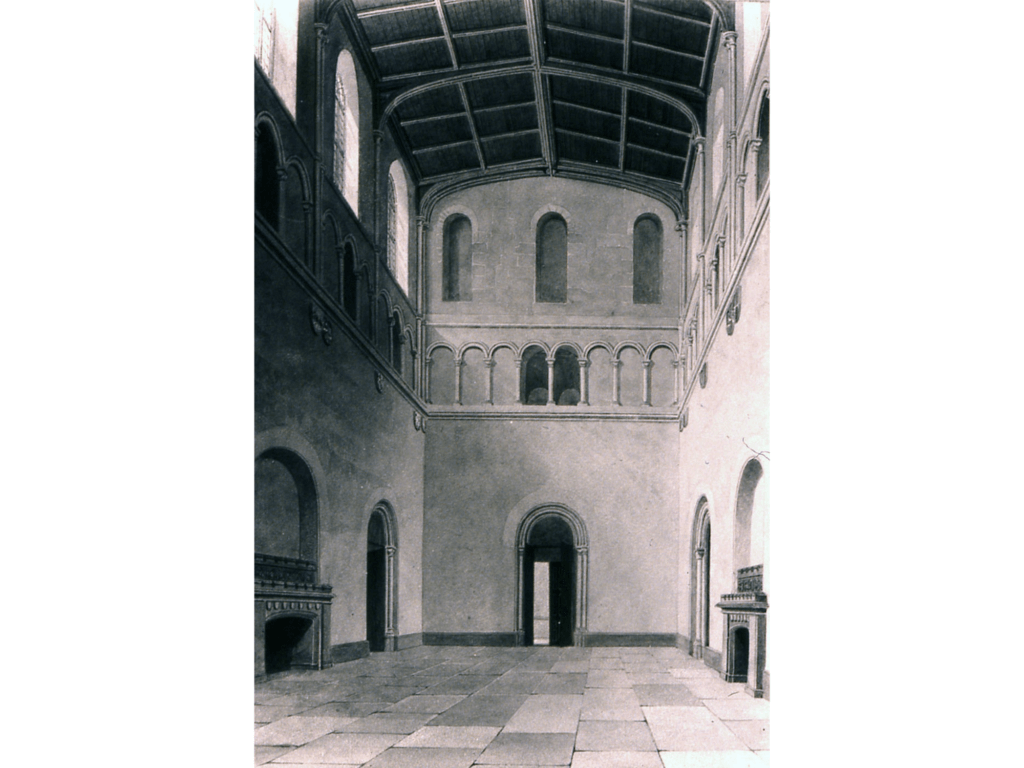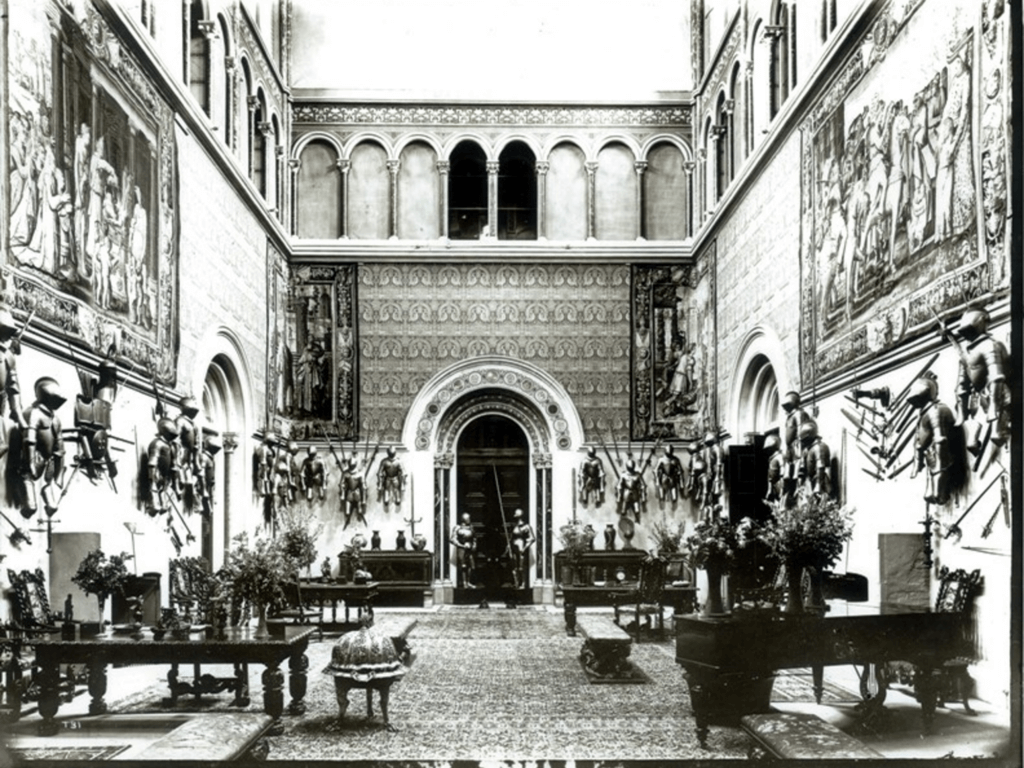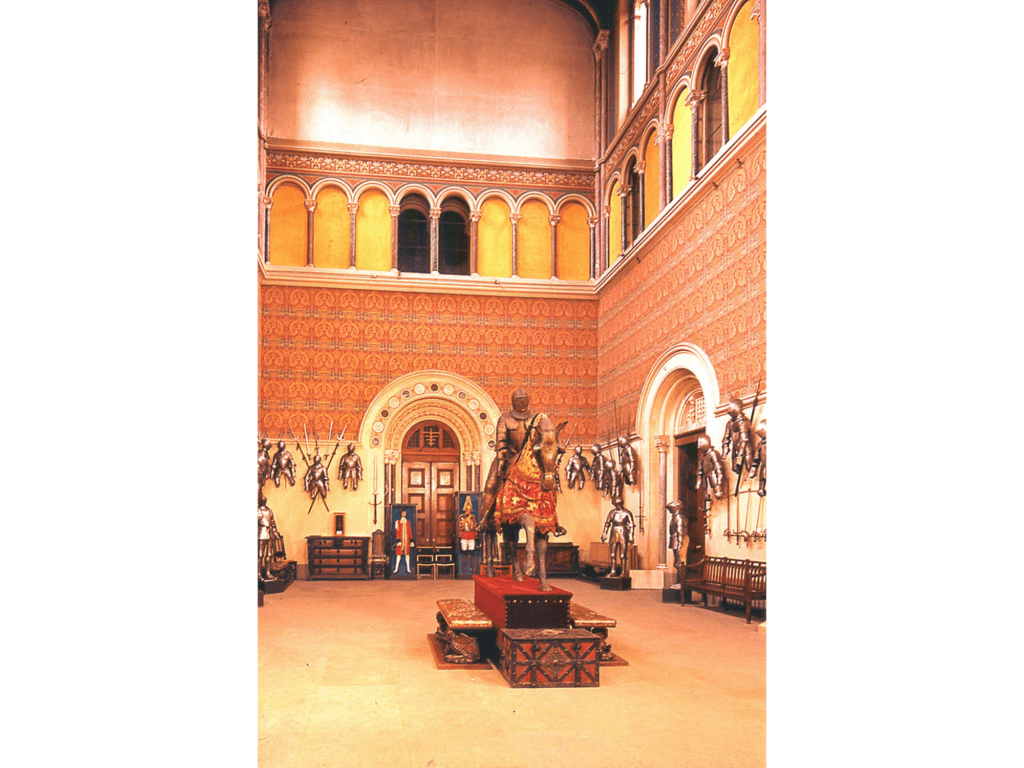First impressions matter. Step through the doors of Eastnor Castle and you expect scale, grandeur and stone. And you get it – the Great Hall rises up around you with its 60-foot ceiling, marble columns and a sense of sheer theatricality.
What you don’t expect? Warmth. Colour. Deep, sumptuous sofas and soft Turkish rugs. It’s this contrast – the drama of a fortress, softened by the comfort of a lived-in home – that gives the Great Hall its particular brand of magic.
But it wasn’t always this way. When Robert Smirke first designed it in 1812 – as shown in the sketch below – it was a bare, medieval-style chamber. Certainly dramatic (you can’t argue with a 60-foot ceiling), but austere. Impressive, yes. Welcoming? Less so.

1812 artist’s impression by Buckler. From the drawings of Robert Smirke, architect of Eastnor Castle
By 1860, the family was ready to soften the mood. There was a moment when the hall might have gone full Gothic; a scheme drawn up by the prolific George Gilbert Scott was considered, then shelved. Instead, they turned to George E Fox to reimagine the space as an Italianate hall. The results were quietly opulent: marble columns from Languedoc and Genoa, carved pilasters by William Forsyth of Worcester and canvas wallcoverings stitched with peacocks (said to be inspired by a Saracen banner brought back from the Crusades).
Over the next 60 years, the Great Hall gathered character via armour, rugs and objets sourced from across Italy. Slowly, it became less of a passageway and more of a place to pause – not unlike the antiques-filled sanctuary it is today.

The Great Hall as it looked from 1865-1920, after work by William Forsyth and George E Fox
But in 1939, that progress stopped. Like many country houses, Eastnor was offered to the government during the war. Although the US army camped in the park, the castle itself went unused, save for a few evacuees from Kent in 1944. The Hall stood empty again, stripped of its contents and, we might add, its energy.
Even after the war, it remained hollow. A few suits of armour returned, but most belongings stayed in storage. Now, the space was cold, quiet, impossible to reconcile with pre-war life. Reinstating its former grandeur felt oddly out of step with the times.

The Great Hall from 1947-1990, after partial refurnishing following the war
Then, in the early 1990s, came Bernard Nevill. A design historian with a collector’s eye – and a seemingly preternatural instinct for how great rooms should feel – Nevill was best known as professor of textiles at Saint Martin’s School of Art. But to Eastnor, he was something more: a visionary. He proposed something unexpected. Not a formal reception hall, but a kind of Edwardian “living hall”; warm, generous and – critically – used. And with central heating newly installed, his idea suddenly didn’t seem so far-fetched.
In 1990, the transformation began. Super-sized sofas were commissioned from Howard Chairs of Camden – regular ones looked miniature in the room’s vast proportions. A large ottoman was added, and new lighting by W Stitch of Soho cast a soft, golden glow. Slowly, the hall began to feel alive again.
Today, its furnishings are deliberately eclectic: a Venetian chair here, a pair of Persian incense burners there. In one corner, a Flemish cabinet topped with vases; in another, a grand piano and a taxidermy owl. Underfoot, a patchwork of Turkish rugs. Overhead, a blue ceiling scattered with stars – not unlike a Renaissance church.
The effect? Pure theatre. We’ve seen it again and again – guests stepping into the space and stopping mid-sentence, mid-step. They look up and take it all in: the height, the warmth, the layered textures and lived-in beauty. It’s unexpected. It’s unforgettable. And for a castle like Eastnor, that’s exactly the point.
